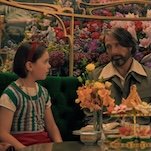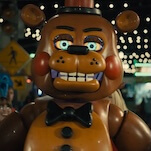So, who will enjoy A Dog’s Purpose? Young children, although they’ll have to be mature enough to be able to handle multiple emotionally manipulative scenes of dogs dying. The elderly, perhaps, but only the sort of older people who think that American culture stumbled blindly off of a moral cliff some time in the mid-1960s. You see, along with its unabashed appeal to sentimental memories of childhood pets, this film revels in mom-and-apple-pie nostalgia for an America that no longer exists, if it ever existed. In that way, it’s not unlike something from the Pure Flix catalog, a characteristic that’s also reflected in its haltingly chaste approach to human relationships. (Keep your eyes peeled for a ridiculously awkward hug in the third act.)
The film is told from the perspective of Bailey (Josh Gad), a dog who is reborn five times over its half-century or so of existence, but is especially hung up on the second one, a long, idyllic farm life with a boy named Ethan and his parents. As often happens with these talking-dog movies, Bailey’s sentience raises more questions than it answers: Why, for example, was Bailey born for the first time in 1950s Michigan, if good dogs are continually reborn? Was there an increase in dog souls to go along with the economic boom of the era? Why is Bailey the only dog that can talk? And why is Bailey’s consciousness developed enough to question the meaning of existence, but not developed enough to learn basic words?
These questions are not addressed by the film itself, which has much more mundane concerns (playing fetch to sappy music, mostly) on its mind. Dramatic conflicts—of which there must be some, or else you might as well stay home and watch Animal Planet—are sketched in the broadest strokes, and expressed through the medium of the dog smelling alcohol on Dad’s breath or knocking down a photo of his owner’s estranged ex-wife with his tail. The scariest sequence in the film—coincidentally, also the one whose filming caused the uproar over animal abuse—comes in Bailey’s life as a female police dog in ’70s Chicago, where she sacrifices herself by jumping into a river to save a kidnapped girl. The funniest is probably Bailey’s life in ’80s suburbia as a lazy Corgi living with a family whose kids like to dress him up in cute costumes, though rest assured that the jokes are as broad as the drama. (Think not one, but two sequences of the dog ruining an important dinner by knocking over the table.) The dialogue in all of them is comically devoid of subtext.
All of Bailey’s lives are shot with gradually decreasing brightness, until Bailey ends up chained to a post outside a run-down house owned by a couple that in an edgier film would have probably been meth addicts. That sequence is shot in a muted gray, but then Bailey escapes and follows his instincts back to the farm where he lived out his second, best life, now owned by an adult Ethan (Dennis Quaid). Newly bathed in sunlight, the film once again amps up the sentimentality, culminating in a groan-worthy title line. So what is a dog’s purpose? To provide gentle, forgettable entertainment for moviegoers who lament that “they” don’t make “nice” movies anymore, apparently. For the rest of us, it’s more like a 100-minute nap.









































